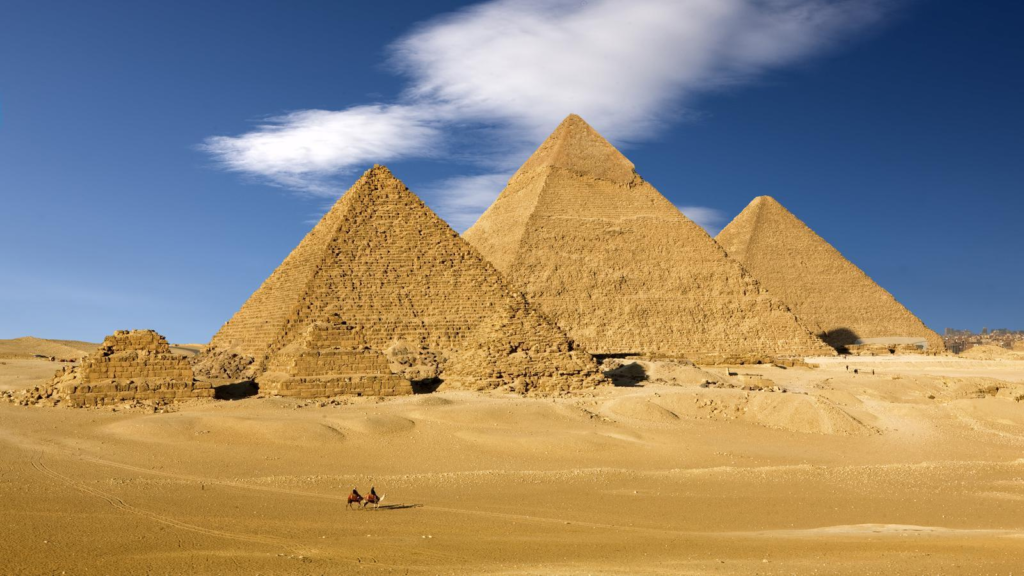
PERHAPS THE MOST impressive and controversial relics to come out of ancient times are the pyramids of Egypt.
The 14 Tablets of Enki & the Anunnaki – Library of Rickandria
The remains of at least seventy to eighty of those structures are scattered all along the upper Nile region as silent reminders of a once powerful civilization.
The largest and most famous Egyptian pyramid is the Pyramid of Cheops (the “Great Pyramid”).
The Great Pyramid – Library of Rickandria
It stands today beside several others on an elevated plateau in Gizeh, Egypt.
The dimensions of this pyramid are impressive.
It towers nearly five hundred feet high and covers thirteen acres of land at its base.
Built of stones weighing an average of 2½ tons each, the entire structure is estimated to weigh 5,273,834 tons.
A remarkable characteristic which makes the Great Pyramid one of the “Seven Wonders of the Ancient World” is the precision of its construction.
The stones of the pyramid were cut so perfectly that a sheet of paper cannot be inserted between the blocks in many places.
This precision, coupled with the enormous bulk of the structure, helps account for the pyramid’s long life and durability.
The pyramid was built to last.
Perhaps the greatest mystery surrounding the Great Pyramid was its purpose.
Most pyramids are thought to have been burial tombs.
History tells us that the Great Pyramid was employed for other purposes, as well.
For example, some of its inner chambers had been used for mystical and religious rites.
Yet a third and infinitely more practical use can also be found:
The Great Pyramid is an excellent marker for aerial navigation.
The four sides of the Great Pyramid precisely face the four compass points:
- north
- south
- east
and west.
The sides are directed so exactly that the widest deviation is only one twelfth of a degree on the east side.
In addition, the Great Pyramid is situated less than five miles south of the northern thirtieth parallel.
The Great Pyramid can therefore be used as a reference point for sectioning the entire planet into a three-dimensional grid of:
- 30
- 60
- 90
degree angles with the:
- North Pole
- South Pole
- Equator
and center of the earth as reference points.
This feature is especially useful because the Great Pyramid is located at the center of the Earth’s land masses.
Knowing only the dimensions of the Earth and having a method of calculating how far one has traveled, one can very effectively navigate, especially by air, from the Great Pyramid to any point on Earth using the 30-60-90 degree grids and the compass directions indicated by the pyramid.
The only deviation comes from the fact that the Earth is not a perfect sphere but is slightly flattened at the poles and widened at the Equator.
However, this deviation is so slight, amounting to only 26.7 miles (.0003367 or the fraction1/298), that it is easily compensated for.
Interestingly, when the Great Pyramid was first built, it was even more valuable as an aerial navigation marker than it is today because it had been covered with a casing of fine white limestone.
The limestone blocks were carved so precisely that the pyramid looked from a distance as though it had been hewn from a single white rock.
The limestone reflected the sun, making the pyramid visible from a much greater distance.
The unique characteristics of the pyramids at Gizeh raise interesting questions about those monuments.
Since they serve an aerial navigation function so well, were they built at least partially for that purpose?
If they were, who could have possibly had use for them in 2000 B.C.?
A possible clue to the riddle may lie on the moon.
On November 22, 1966, the Washington Post ran a front-page headline proclaiming:
“Six Mysterious Statuesque Shadows Photographed on the Moon by Orbiter.”
The Post story, which was picked up later by the Los Angeles Times, described a lunar photograph snapped two days earlier by U.S. space probe Orbiter 2 as it passed twenty to thirty miles above the moon’s surface.
The photograph seems to reveal six spires arranged in a purposeful geometrical pattern inside a small portion of the Sea of Tranquility.
The pointedness of the lunar objects’ shadows indicates that they are all either cone – or pyramid-shaped.
Although the official NASA press release mentioned nothing unusual about the photograph, other people found the picture remarkable.
Dr. William Blair of the Boeing Institute of Biotechnology stated:
“If the cuspids [cone-shaped spires] really were the result of some geophysical event it would be natural to expect to see them distributed at random.
As a result, the triangulation would be scalene [three unequal sides] or irregular, whereas those concerning the lunar object led to a basilary system, with coordinate x, y, z to the right angle, six isosceles triangles and two axes consisting of three points each.”
“Most of the limestone is gone today.
Except for a few blocks found at the base of the Great Pyramid, the limestone casing had been excavated away from the pyramids beginning in the first millennium A.D.”
In Argosy magazine, Soviet space engineer Alexander Abromov went a step further by stating:
The distribution of these lunar objects is similar to the plan of the Egyptian pyramids constructed by Pharaohs Cheops, Chephren, and Menkaura at Gizeh, near Cairo.
The centers of the spires of this lunar “abaka” [arrangement of pyramids] are arranged in precisely the same way as the apices [tips] of the three great pyramids. [2]

[Alexander Grigoryevich Abramov (Russian: Александр Григорьевич Абрамов, born 20 February 1959) is a Russian businessperson, who until March 2022 was the Chairman of the Board of directors of Evraz, one of Russia’s largest steel producers. Since 1998, he has amassed one of the largest steel and iron empire in Russia, which employed 71,591 people around the world, with steel output of 13,57 million tones and turnover of $14,1 billion in 2021, leading to him be widely considered a Russian oligarch. A business partner and ally of Aleksandr Frolov and Roman Abramovich, Abramov was in June 2021 listed by Forbes as having an estimated net worth of $8.0 billion.]
Assuming Drs. Blair and Abromov have not grievously miscalculated, it appears that some of the pyramids of Earth may be part of a permanent marking system that extends to more than one planet of our solar system.
The system may even extend to Mars. Pyramid like objects have been photographed on the Martian surface.
Pictures snapped by the U.S. Viking mission in 1976 show the Martian region of Cydonia to contain possible pyramid like objects and what appears to be a huge, sculpted face nearby staring skyward.
It is easy to argue that the Martian pyramids and face are natural formations not unlike some found on Earth; however, one, and possibly two, other “faces” have been discovered elsewhere on Mars with strikingly similar features, such as the “helmet,” cheek notches, and indentation above the right eye. **
Perhaps equally interesting is the fact that one pyramid in Cydonia has a side pointing due north towards the Martian spin axis. Is this alignment chance, or is there a connection to the Great Pyramid at Gizeh which is also aligned according to precise compass directions?
It is, of course, possible that the objects on the moon and Mars will prove to be rock formations after all.
Available photographs seem inadequate to establish the formations as artificial.
If they are artificial, it is clear from the photographs that they have undergone a fair degree of erosion.
Only a closer look during future missions to the moon and Mars will resolve the controversy.
The objects are certainly worth closer investigation because the moon has hosted UFO phenomena for centuries, including inside the Sea of Tranquility. [3]
Even if the Martian or lunar objects prove to be natural formations, that would not change the clearly artificial nature of Earth’s pyramids.
This compels us to return our focus to the pyramids of Egypt.
For whom did the ancient Egyptians say they were building their magnificent structures?
Like the ancient Mesopotamians, the early ancient Egyptians claimed to be living under the rule of humanlike extraterrestrial “Gods.”
The Egyptians wrote that their “Gods” traveled into the heavens in flying “boats.”
(These “boats” were later mythologized to explain the movement of the sun.)
The “Gods” of Egypt’s early period were said to be literal flesh-and-blood creatures with the same needs for food and shelter as human beings.
Actual homes had been built for them.
Those homes were furnished with human servants who later became Egypt’s first priests.
According to renowned historian James Henry Breasted, the earliest servants of the “Gods” were laymen who performed their duties without ceremony or ritual.
Their jobs consisted simply of providing the “Gods” with,
“. . . those things which formed the necessities and luxuries of an Egyptian of wealth and rank at that time: plentiful food and drink, fine clothing, music and dance.”
Many people identify ancient Egyptian religion with the worship of animals.
This type of veneration was unknown during the early period of the Egyptian civilization.
According to Professor Breasted:
An interesting compilation of unusual lunar phenomena is found in NASA Technical Report R-277 entitled “Chronological Catalog of Reported Lunar Events” by Barbara M. Middlehurst.
It briefly lists 579 unusual lunar sightings considered to be reliable beginning in the year 1540 and ending in 1967.
… the hawk, for example, was the sacred animal of the sun-God, and as such a living hawk might have a place in the temple, where he was fed and kindly treated, as any such pet might be; but he was not worshipped, nor was he the object of an elaborate ritual as later. [4]
Chronological Catalog of Reported Lunar Events NASA TR R-277 (bibliotecapleyades.net)
The records of ancient Egypt have given us many clues as to who might have had use for a permanent marking system to navigate various planets of our solar system:
the Custodial society.
Egypt: Land of Kemet – Library of Rickandria
The first pyramid of Egypt was designed by Imhotep, Prime Minister to Egyptian king Zoser-Neterkhet.
Imhotep was said to be the son of Egypt’s most important Custodial “God” during his day:
Ptah.
Egyptian lore written after Imhotep’s time adds that Imhotep had received the pyramid design in a plan,
“Which descended to him from heaven to the north of Memphis [a city in ancient Egypt].” [5]
The Great Pyramid at Gizeh, which was built several generations later during the “Age of the Pyramids,” was constructed according to the methods established by Imhotep.
It was during the Age of the Pyramids, which began around 2760 B.C., that worship of the humanlike “Gods” reached its height; more than 2000 Gods then existed.
It was for their “Gods” that the Egyptians had ultimately built their most important pyramids.
The many pyramids built after those at Gizeh are generally inferior and are viewed as imitations.
Some theorists believe that the “ancient astronauts” of Egypt had used their space age technology to lift stones and to otherwise assist in the construction of the Gizeh pyramids.
Ancient Astronauts Theory – Library of Rickandria
This hypothesis is neither certain nor necessary to sustain the “ancient astronaut” theory.
Egyptian records tend to support the idea that human labor had provided the primary muscle for the pyramids’ construction.
This would have been in keeping with the Mesopotamian contention that Homo sapiens had been created to be a labor pool for the Custodial “Gods.”
It is hardly surprising that the pharaohs and priests who acted on behalf of the “Gods” were often immensely unpopular with the Egyptian people.
The Old Kingdom (ca. 2685-2180 B.C.) was followed by a period of weakness and unrest.
Even the Great Pyramid of Cheops had been broken into by unhappy Egyptians.
According to historian Ahmed Fakhry:
The Egyptians so hated the builders of the pyramids that they threatened to enter these great tombs and destroy the mummies of the kings. [6]
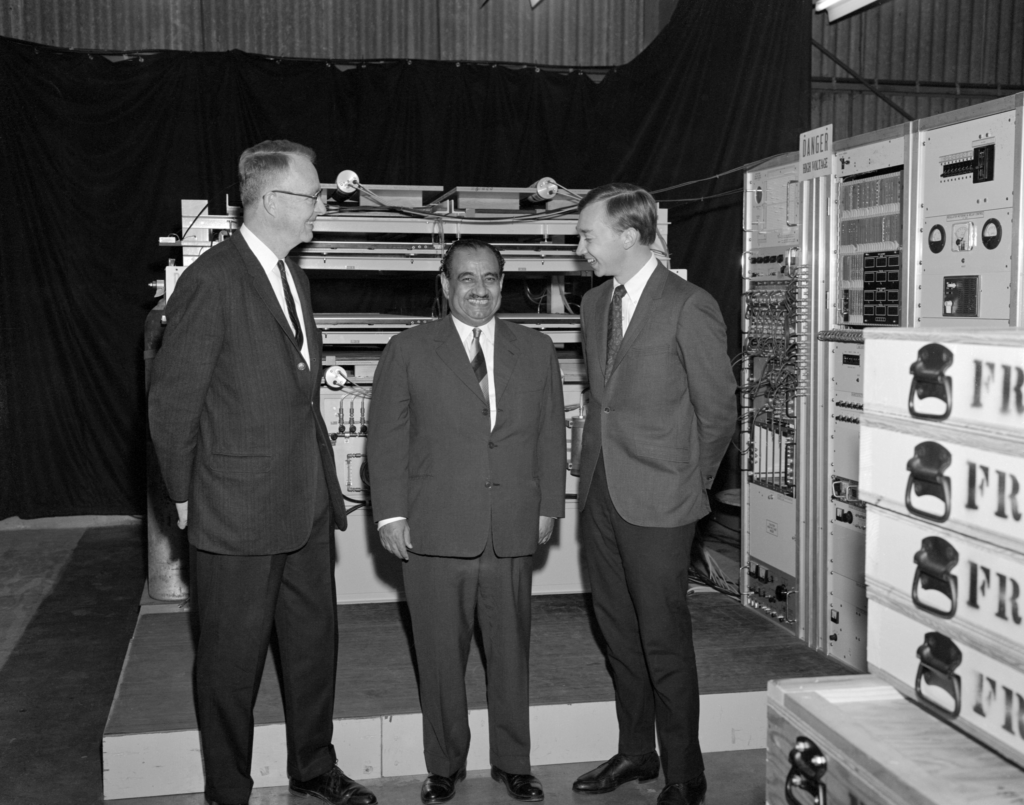
[Ahmed Fakhry (Arabic: أحمد فخري) (born in Faiyum Governorate in 1905 – Paris, 7 June 1973) was an Egyptian archaeologist who worked in the Western desert of Egypt (including in 1940 dig at El Haiz, and then at Siwa), and also in the necropolis at Dahshur.]
Such intense loathing is certainly not surprising.
In order to get the great pyramids built, Egyptian society was made more repressive in order to make human labor operate with greater machinelike efficiency.
Occupations became rigid so that it was difficult to move from one type of job to another.
Laymen ceased to serve the “Gods”:
an impenetrable priesthood was erected instead.
Personal happiness and achievement were sacrificed in the name of labor productivity.
Feudalism had arrived in Egypt.
As the pharaohs were busy helping to make slaves out of their fellow humans, the “Gods” were making fools out of the pharaohs.
Imhotep, reputed son of the “God” Ptah, instituted the concept of the pharaoh as “God-King.”
This elitist title was little appreciated by most Egyptians.
As “God-Kings,” the pharaohs were made to think that they were elevated above the toiling human multitudes.
The pharaohs were taught that if they cooperated with Custodial plans, they would escape the human predicament by joining the “Gods” in the heavens.
There was just one catch.
The pharaohs would be allowed to escape Earth only after they had died!
Pharaohs were taught the silly idea that if they had their dead bodies carefully preserved, the bodies would be brought back to life, and they could join the Custodial “Gods” in the heavens.
Some pharaohs, like Cheops, also buried large wooden boats near their tombs.
According to some scholars, the pharaohs believed that their entombed boats (“solar barks”) would be magically exhumed and endowed with the same power that caused the “boats” of the “Gods” to fly.
The pharaohs believed that they would be whisked away after death in their magically powered wooden boats to the home of the “Gods” in the heavens.
Although Egyptian preservation techniques were quite good, it is clear that the pharaohs’ minds were being filled with nonsense.
The wooden “solar barks” never flew.
Few, if any, mummified bodies of the great God-Kings reached the heavens.
Instead, many mummies have become macabre museum curiosities for the titillation of the human multitudes that the pharaohs so fervently hoped to escape.
Other mummies suffered an even more humiliating fate:
they were ground up and used as an ingredient in medicines.
Pulverized mummies also became paint additives because of the preservatives used in the mummification process.
The puzzle is why the pharaohs believed the cruel joke which had been perpetrated on them.
Some historians suggest that mummification was an attempt to imitate the life cycle of the butterfly.
Others believe that the pharaohs wanted to maintain their wealth and position in their next lifetimes and therefore desired to be resurrected in the same bodies.
One UFO writer has suggested that they were striving to duplicate body preservation techniques used by Egypt’s technologically advanced “Gods.”
Ancient Egyptian records, however, reveal an even more compelling reason why the pharaohs mummified themselves:
spiritual knowledge had been twisted.
Ancient Egyptians believed in a “soul,” or “serf,” as an entity completely separate from the “person” (meaning “body”).
Egyptians labeled one such spiritual entity the “ka.”
The Egyptians believed that the “ka,” not the body, was one of the spiritual entities that constituted the true person and that the body itself had no personality or intelligence without a spiritual entity.
This generally enlightened view was given a false twist, however.
The Egyptians were made to believe that the spiritual well of the “ka” after death depended upon the “ka” maintaining contact with a physical body.
According to historian Fakhry:
The Egyptian wanted his Ka to be able to recognize its body after death and to be united with it; for this reason he felt that it was very important to have his body preserved.
This is why the Egyptians mummified their bodies and excelled in embalming them. [7]
The pharaohs went even a step further. Mr. Fakhry explains:
The Egyptians also made statues and placed them in tombs and temples to act as substitutes for the body if it should perish. [8]
These practices had a devastating impact on spiritual understanding.
They caused people to wrongly equate spiritual wholeness with spiritual attachment to human bodies (or to body substitutes).
Such teachings encouraged humans to accept the Custodial intention to permanently join spiritual beings to Homo sapiens bodies.
The powerful human drives for spiritual integrity and immortality were twisted into an obsessive quest to preserve bodies.
Philosophies of materialism were thereby hastened.
Materialism, by one of its definitions, is the over preoccupation with things at the material level and neglecting important aspects of ethical and spiritual existence.
This often leads to the second definition of materialism: the belief that everything, including thought and emotion, can be explained entirely by movements and changes in physical matter.
Although the Egyptians had not embraced the latter definition as a philosophy of life, they had helped move the world a step in that direction.
The derailment of spiritual knowledge in Egypt was caused by the corruption of the Brotherhood of the Snake, to which the pharaohs and priests belonged.
As mentioned earlier, after its reported defeat thousands of years ago by its Custodial enemies, the Brotherhood continued to remain dominant in human affairs, but at the cost of becoming a Custodial tool.
To understand how the corrupted Brotherhood began to distort spiritual truth and perpetuate theological irrationality, we must first look at the early inner workings of the Brotherhood and its method of teaching.
The original uncorrupted Brotherhood engaged in a pragmatic program of spiritual education.
The organization’s approach was scientific, not mystical or ceremonial.
The subject of the spirit was considered to be as knowable as any other science.
It seems that the Brotherhood possessed a considerable body of accurate spiritual data, but it had not succeeded in developing a complete route to spiritual freedom prior to its defeat.
Brotherhood teachings were arranged as a step-by-step process.
A student was required to satisfactorily complete one level of instruction before proceeding to the next one.
All pupils took oaths of secrecy in which they swore never to reveal the teachings of a level to any person who had not yet graduated up to that level.
This style of instruction was designed to ensure that a student did not prematurely attempt difficult spiritual feats or become overwhelmed by advanced level-information before he was ready for it, in the same way that one does not take a student driver on treacherous mountain roads before the student successfully navigates easier, but increasingly difficult, highways first.
Imparting spiritual knowledge in this fashion will be effective as long as the levels are ultimately open to everyone.
When arbitrary or blanket restrictions are placed on who may have access to the teachings, either through overregulation, elitism, or by setting near-impossible conditions for admittance, the system of confidential step-by-step levels changes from an educational tool into an instrument of spiritual repression.
The Brotherhood underwent just such a change.
The teachings of the Brotherhood in ancient Egypt were organized into an institution known as the “Mystery Schools.”
The Schools furnished the pharaohs and priests with most of their:
- scientific
- moral
- spiritual
education.
According to Dr. H. Spencer Lewis, founder of the Rosicrucian Order headquartered in San Jose, California, *** the first temple built for use by the Mystery Schools was erected by Pharaoh Cheops.
Inside those temple walls, spiritual knowledge underwent the deterioration which caused pharaohs to mummify their bodies and bury wooden boats.
According to old Egyptian lore, the distorted teachings of the Mystery Schools were created by the “great teacher,” Ra, an important Custodial “God.”
The Mystery Schools not only twisted spiritual knowledge, but they also greatly restricted public access to any theological truths still surviving.
Only the pharaohs, priests, and a few others deemed worthy were accepted into the Schools.
Initiates were required to take solemn vows never to reveal to any outsiders the “secret wisdom” they were taught; students were threatened with dire consequences if they broke the vow.
These restrictions were reportedly established to prevent misuse of high-level knowledge by those who might degrade that knowledge or use it harmfully.
While this is a legitimate reason to develop safeguards, the restrictions imposed by the Mystery Schools went far beyond simple security.
Entire social and occupational groups were denied membership.
The vast majority of the human population had no hope of entering the Schools; their access to any surviving spiritual knowledge was therefore severely limited.
The Biblical “revolving sword” preventing access to the “tree of knowledge” was being put into place by those who ran the Mystery Schools.
The Mystery Schools caused spiritual knowledge to evaporate in another way.
The Schools forbade its members from physically recording the Schools’ most advanced teachings.
Initiates were required to relay the information orally.
There is no faster way to lose knowledge than to forbid its being written down.
No matter how sincere and well-trained people may be, word-of-mouth will invariably result in changes to the ideas being relayed.
With a word substituted here and a sentence omitted there, the semantic precision needed to communicate an exact scientific principle will be lost.
This is one way that a functional science can quickly degrade into an untenable superstition.
SCIENCE – Library of Rickandria
As time went on, the Brotherhood became so restrictive that it excluded most of Egypt’s own priests from membership.
This was especially true during the reign of King Thutmose III, who ruled about 1200 years after Cheops.
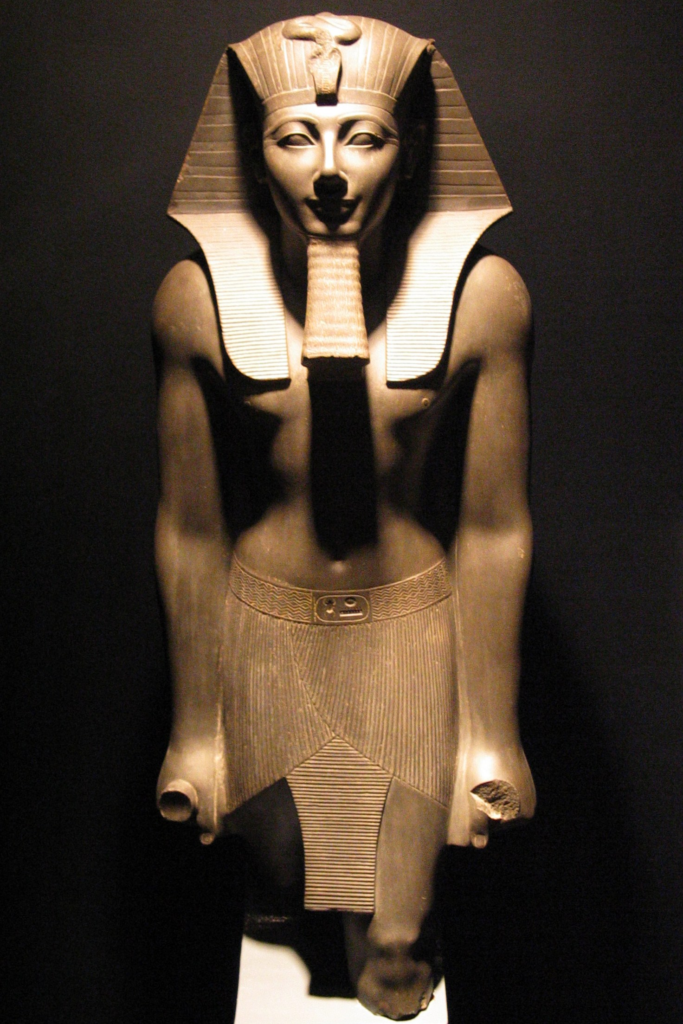
[Thutmose III (variously also spelt Tuthmosis or Thothmes), sometimes called Thutmose the Great, was the sixth pharaoh of the 18th Dynasty. Officially he ruled Egypt from 28 April 1479 BC until 11 March 1425 BC, commencing with his coronation at the age of two and concluding with his death, aged fifty-six; however, during the first 22 years of his reign, he was coregent with his stepmother and aunt, Hatshepsut, who was named the pharaoh.]
Thutmose III is best known for his military adventures which expanded the Egyptian empire to its greatest size.
According to Dr. Lewis, Thutmose III took the final step of transforming the Brotherhood into a completely closed order.
He established rules and regulations reportedly still used by some Brotherhood organizations today.
Changes in the Brotherhood continued.
Less than one hundred years after the reign of Thutmose III, his descendant, King Akhenaton (Amenhotep IV), spent the last year of his 28-year life transforming Brotherhood teachings into mystical symbols.

[Akhenaten (pronounced /ˌækəˈnɑːtən/), also spelled Akhenaton or Echnaton (Ancient Egyptian: ꜣḫ-n-jtn ʾŪḫə-nə-yātəy, pronounced [ˈʔuːχəʔ nə ˈjaːtəj], meaning ‘Effective for the Aten’), was an ancient Egyptian pharaoh reigning c. 1353–1336[3] or 1351–1334 BC, the tenth ruler of the Eighteenth Dynasty. Before the fifth year of his reign, he was known as Amenhotep IV (Ancient Egyptian: jmn-ḥtp, meaning “Amun is satisfied”, Hellenized as Amenophis IV).]
Akhenaton’s symbols were intentionally designed to be incomprehensible to everyone except those Brotherhood members who were taught the symbols’ secret meanings.
The Brotherhood ostensibly created this new system of visual images to be a universal “language” of spiritual enlightenment transcending human languages, and to prevent misuse of knowledge.
In real fact, the intention was to create a secret code designed to make spiritual knowledge unattainable to everyone except those admitted into the increasingly elite Brotherhood, and apparently to eventually obliterate spiritual knowledge altogether.
The translation of spiritual data into bizarre and incomprehensible symbols has brought about the spectacle of honest people trying to decode garbled symbols in a quest for spiritual truths which can, and should be, communicated in everyday language understandable by anyone.
Despite the obvious sincerity of Akhenaton, we discover that the transformation of spiritual knowledge into a system of obscure symbols has had a devastating impact on human society.
As this manner of relaying spiritual knowledge was disseminated throughout the world by members of the Brotherhood, all knowledge of a spiritual nature became misidentified with bizarre symbols and mystery.
This misidentification is so strong today that almost all studies of the spirit and spiritual phenomena are lumped into such disgraced classifications as “occultism,” “spiritualism,” and witchcraft.
WITCHCRAFT – Library of Rickandria
The attempt thousands of years ago to keep spiritual knowledge out of the hands of the “profane” has almost entirely destroyed the credibility and utility of that knowledge.
Brotherhood symbolism was another piece of the Biblical “revolving sword” blocking human access to spiritual knowledge.
It has left only the confusion, ignorance and superstition which have come to characterize so much of the field today.
Akhenaton presided over another important development in the Brotherhood.
Although the young ruler had fared poorly as a political leader, he achieved everlasting fame for his efforts to champion the cause of monotheism, i.e., the worship of a “one only” God.
Monotheism was a Brotherhood teaching, and many historians cite Akhenaton as the first important historical figure to broadly promulgate the concept.
To aid in the establishment of the Brotherhood’s new monotheism, Akhenaton moved the capital of Egypt to the city of El Amarna.
He also relocated the main temple of the Brotherhood there.
When the Egyptian capital was moved back to its original situs, the Brotherhood remained in El Amarna.
This signaled an important break between Egypt’s established priesthood, which resisted Akhenaton’s monotheism, and the highly exclusive Brotherhood which no longer admitted most priests to membership.
The ancient Egyptian empire eventually decayed and vanished.
The Brotherhood of the Snake fared much better.
It survived and expanded by sending out from Egypt missionaries and conquerors who established Brotherhood branches and offshoots throughout the civilized world.
These Brotherhood emissaries widely disseminated the Brotherhood’s new “one God” religion and eventually made it the dominant theology throughout the world.
In addition to launching “one God” theology, the Snake Brotherhood created many of the symbols and regalia still used by some important monotheistic religions today.
For example, the Brotherhood temple in El Amarna was constructed in the shape of a cross—a symbol later adopted by the Brotherhood’s most famous offshoot:
Christianity.
Christian Program & Purpose – Library of Rickandria
Some Brotherhood members in Egypt wore the same special outfits with a “cord at the loin” and a covering for the head as later used by Christian monks.
The chief priest of the Egyptian temple wore the same type of broad-sleeved gown used today by clergymen and choir singers.
The chief priest also shaved his head in a small round spot at the top—an act later adopted by Christian friars.
Exposing Christianity – Library of Rickandria
Many theologians hail monotheism as an important religious breakthrough.
Worshipping a spiritual “one-only God” is indeed an improvement over the idolization of stone statues and clumsy animals.
Unfortunately, Brotherhood monotheism still did not represent a return to complete accuracy; it simply added new distortions to whatever spiritual knowledge still remained.
Based upon what we are coming to know about the nature of the spiritual being, we find that two false twists appear to lay in the Brotherhood’s definition of a Supreme Being:
Firstly, Brotherhood monotheisms, which include:
- Judaism
- Christianity
- Islam
teach that a Supreme Being was the creator of the physical universe and of the physical life forms within the universe.
The Real Truth: Jews Promote Christianity & Islam – Library of Rickandria
In an upcoming chapter we will discuss the likelihood that spiritual beings were born of a Supreme Being of some sort, but physical creatures and objects probably were not.
As some other religions have noted, if our universe is the product of spiritual activity, then it appears that all individual spiritual beings within the universe are responsible for its creation and/or perpetuation.
The scope of a Supreme Being would actually extend far beyond the creation of a single universe.
Secondly, a Supreme Being is usually portrayed as a spiritual being capable of possibly unlimited:
- thought
- creativity
- ability
A Supreme Being is said to be an entity which can make and unmake universes.
The big question is this:
Why must we be limited to only one such being?
Is there any reason not to suppose the existence of ten such beings?
Or a hundred?
Or an almost infinite number?
It appears that the Brotherhood definition of a “one God” actually describes the native potential of every spiritual being, including those spiritual beings who animate human bodies on Earth.
The true nature and capabilities of every spiritual being would therefore be hidden by doctrines which state that only a Supreme Being may enjoy pure spiritual existence and unlimited spiritual potential.
Brotherhood monotheism would actually hinder human spiritual recovery and prevent people from grasping the true, and probably much broader, scope of a Supreme Being. ****
Brotherhood monotheism was another piece of the Biblical “revolving sword” to prevent access to spiritual knowledge. It also allowed the Custodians to greatly elevate then-own status.
As part of its new monotheism, the Brotherhood began to teach the fiction that members of the Custodial race were the physical manifestations of a Supreme Being.
In other words, Custodians started pretending that they and their aircraft were the “one-only God.”
History records that they used extraordinary violence to make Homo sapiens believe the falsehood.
Few lies have had as devastating an impact on human society, yet it became a prime mission of the corrupted Brotherhood, from the time of Akhenaton the modern day, to make humans believe that the Custodians and their aircraft were “God.”
The purpose of this fiction was to enforce human obedience and to maintain Custodial control over the human population.
In no case is this clearer, or the results more visibly tragic, than in the Biblical story of the ancient Hebrews and their “one God” named Jehovah.
YHVH: The Truth About “Yahweh/Jehovah” – Library of Rickandria
***
Rosicrucianism is one of the mystical systems which arose out of Brotherhood teachings. Dr. Lewis’s Rosicrucian Order is called The Ancient and Mystical Order Rosae Crucis (“AMORC” for brevity).
AMORC was founded in the early 1900’s.
Ancient Mystical Order Rosae Crucis – Wikipedia
It is best known today for the popular Egyptian Museum it owns and operates in San Jose, California.
There is another American Rosicrucian order headquartered in Quakertown, Pennsylvania.
It is called the Fraternity of the Rosy Cross, or The Rosicrucian Fraternity in America.
The Rosicrucian Fraternity in Quakertown does not recognize AMORC as a valid Rosicrucian body.
In the 1930’s and 1940’s, R. Swinburne Clymer, Supreme Grand Master of the Rosicrucian Fraternity in Quakertown, published a number of writings denouncing AMORC.
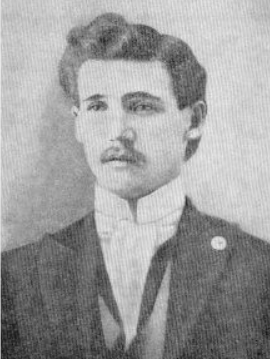
[Reuben Swinburne Clymer (November 25, 1878 – June 3, 1966) was an American occultist and modern Rosicrucian Supreme Grand Master of the FRC (Fraternitas Rosae Crucis), perhaps the oldest continuing Rosicrucian organization in the Americas. He practiced alternative medicine and wrote and published works on it as well as (his version of) the teachings of Paschal Beverly Randolph (1825-1875), alchemy, nutrition, religion, sex magic and spiritualism. This led to a number of conflicts with Harvey Spencer Lewis (1883-1939) and the AMORC (Ancient Mystical Order Rosae Crucis), FUDOSI, Aleister Crowley, and even the American Medical Association.]
Dr. Clymer and Dr. Lewis have each claimed that his organization is the true Rosicrucian system.
In this book, I have utilized the extensive historical research of both Dr. Clymer and Dr. Lewis.
When I cite either of them by name as a source of historical information, I am not taking sides in their controversy.
****
A fuller discussion of the possible nature of a Supreme Being and its relationship to individual spiritual existence is presented in Chapter 40.
The Gods of Eden – Chapter 6: The Pyramid Builders (basecamp.com)
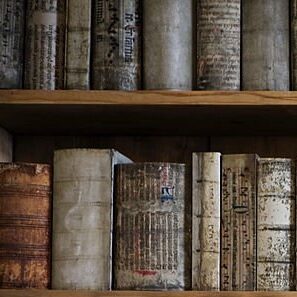
Leave a Reply